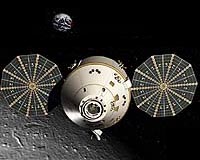 |
Bonn, Germany (SPX) Sep 08, 2009 From 7-21 September 2009, the German Aerospace Center will perform, for the 14th time, a series of research flights to provide weightlessness conditions, using the Airbus A300 ZERO-G. The event will also celebrate ten years of activity for DLR's parabolic flight programme for microgravity research. The largest flying laboratory in the world will take off from Cologne/Bonn airport for a total of five research flights. Scientists will use these flights for experiments in biology, medicine, physics, materials research and technology.
Weightless in the sky In the resulting freefall, there is almost zero gravity for passengers and experiments for around 22 seconds. Scientists use these conditions for research and to prepare complex experiments for the ISS. In addition, medical studies are expected to improve the health conditions of astronauts in space and of humans on Earth.
1538 parabolas in ten years In addition, students from schools and universities are also using the opportunity provided by the parabolic flights for their biological and medical experiments. Also, two artistic experiments have also been on board to date. In the 1538 parabolas, the researchers have had a total of at least nine hours of zero gravity conditions at their disposal. The 14 experiments of the current parabolic flight series include a trial from the University of Magdeburg to analyse cells that contribute to the formation and deterioration of bones. The results will form the foundation of the development of promising measures to prevent osteoporosis. Osteoporosis, or bone deterioration, is a big problem in the human aging process. Osteoporosis also affects young, physically healthy and very fit astronauts during the time they spend in space. It can, however, be completely reversed after they return to Earth. Flights under space conditions offer a good opportunity to examine the causes of osteoporosis in healthy people. Another experiment, from the Leibniz Institute for New Materials in Saarbrucken, is dedicated to the question of how we can make technical improvements to certain nanomaterials that, for example, can make surfaces scratch-proof or resistant to bacteria. Nanowires made from different alloys play an important role in this context. We already know that gravity plays a part in their manufacture. Now, the goal is to examine this process for the first time in zero gravity conditions in order to better understand it and optimise it on Earth.
Research in weightlessness conditions As a link between the long-term research on the International Space Station (ISS) and research and development on Earth, parabolic flights represent a 'bridge into space' from both scientific and technological perspectives. DLR offers parabolic flights once or twice a year. Although the 22 seconds of weightlessness per parabola is very short, innovations in the area of measuring technology allow manifold experiments on parabolic flights today than was possible during DLR's first parabolic flight in 1999. Parabolic flights are an important addition to the experimentation possibilities that the DLR Space Agency makes available to science: from the drop tower in Bremen, where zero gravity conditions can be achieved for up to nine seconds in an evacuated tube, to rockets and satellites on which automatic experiments can take place over several minutes or weeks, to the ISS. The special benefit of the parabolic flights is that scientists can work on their experiments themselves during the flight and carry out a variety of test procedures using their own laboratory devices. Flying on the aircraft is generally possible for research teams within one year of lodging their application. Share This Article With Planet Earth
Related Links German Aerospace Center Space Tourism, Space Transport and Space Exploration News
 Lockheed Martin Says Orion Is Go For CDR
Lockheed Martin Says Orion Is Go For CDRHouston TX (SPX) Sep 03, 2009 With a unanimous vote by NASA's Constellation and Orion Project managers, the Lockheed Martin-led industry team building the Orion crew exploration vehicle successfully passed a significant milestone in the new spacecraft's development phase - the preliminary design review. Successful completion of the PDR stage allows the team to enter Orion's critical design review (CDR) phase, a ... read more |
|
| The content herein, unless otherwise known to be public domain, are Copyright 1995-2009 - SpaceDaily. AFP and UPI Wire Stories are copyright Agence France-Presse and United Press International. ESA Portal Reports are copyright European Space Agency. All NASA sourced material is public domain. Additional copyrights may apply in whole or part to other bona fide parties. Advertising does not imply endorsement,agreement or approval of any opinions, statements or information provided by SpaceDaily on any Web page published or hosted by SpaceDaily. Privacy Statement |